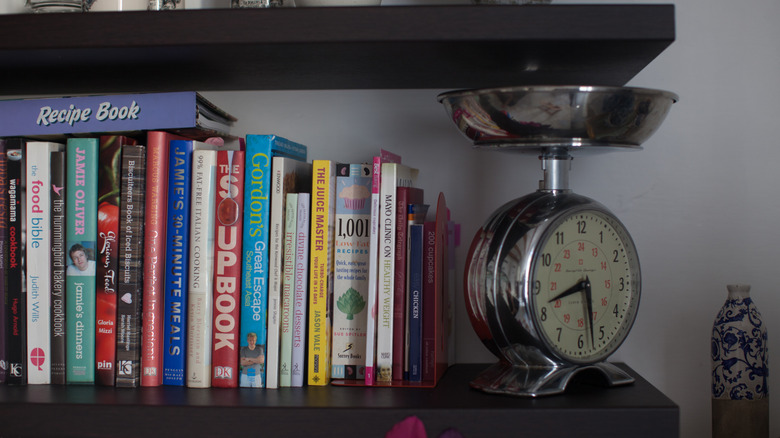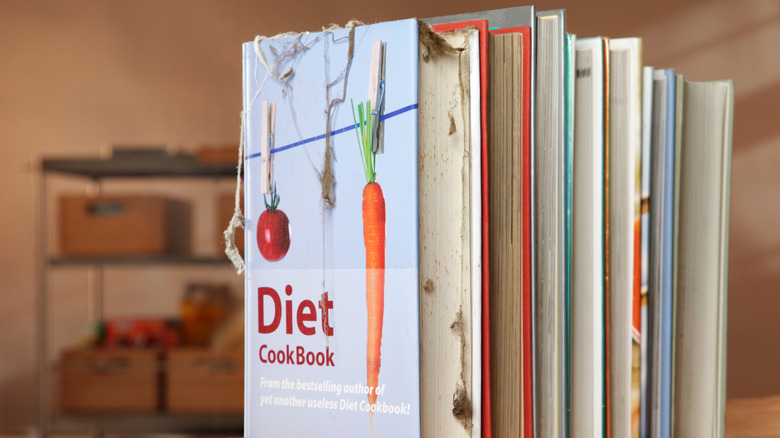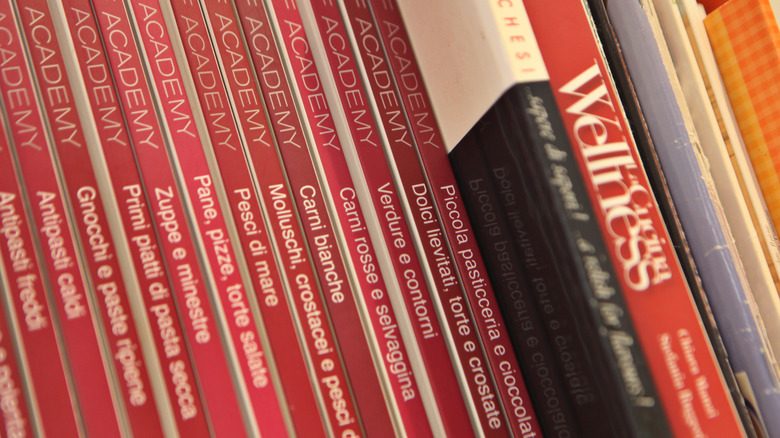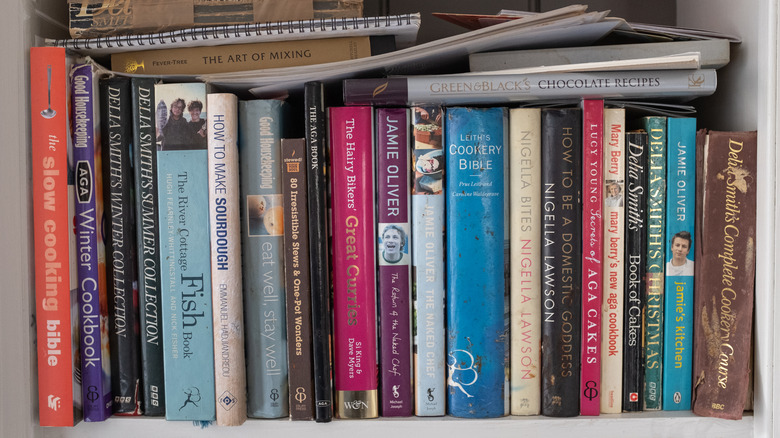Find Your Favorite Cookbooks Faster With These Simple Organizing Techniques
We may receive a commission on purchases made from links.
The internet offers an enormous breadth of culinary tips, but there's a special magic to a good old-fashioned cookbook. You can flip open the pages, glance at the beautiful photos, and read the curated recipes in a refreshingly self-contained experience. And the knowledge these volumes offer is expansive, from cookbooks highlighting the world's best restaurants to compendiums of classic recipes. No surprise that for many home cooks, the cookbooks start stacking up.
As the culinary library keeps growing, it's essential to set up organizational methods. Not only does this prevent a cluttered eyesore, it also helps you find your favorite cookbooks faster. Best of all, the tips don't require intensive effort. You can group books by cuisine or color, invest in a shelf to highlight certain texts, employ either analog or electronic methods to note specific recipes, and simply keep your most referenced books more accessible. Spend an hour or less organizing, and pinpointing a weeknight recipe gets much easier.
Group specific cuisines and techniques together
While they are often a joy to read, cookbooks are defined by their utilitarian purpose. Accordingly, group books based on their application. Whether it's specific cuisines, the best cookbooks for bakers, or more specific techniques such as butchering or barbecue, it's helpful to delineate each category. If you're limited on shelf-space you can even split up sections across varying locations. You can also purchase a portable storage bin, such as one from the Lakeside Collection, to pull out a whole category at a time.
Locating the book you need should be a breeze: Simply peruse the necessary category for the theme of the night. Furthermore, such an organizational style is the best way to expand your repertoire. Say you're in the mood for Italian; instead of consistently relying on the same go-to reference, you can spontaneously browse another text for the meal. In addition to inspiring better categorization, such a method endorses creativity.
Use shelves to emphasize certain books
Cookbooks get clustered, competing for space not just from each other, but from other culinary appliances, too. To highlight the volumes you need, split up your go-to's from the ones you consult every once in a while. Place these favorites on a display shelf in or near the kitchen, with their covers facing out front. Not only is locating these book be a breeze, but guests can curiously peruse your selection — whether it's an indispensable classic cookbook or a new niche offering. If you start to miss a certain volume, you can always rotate it onto the star shelf. Plus, you can employ the aesthetic cover art as decoration, showing off the graphic design.
Meanwhile, there's nothing wrong with filing away the rest of the books into a cabinet or drawer. If limited on space, you can even store in a home office or closet. Oftentimes, the less-used books are referenced for just a meal or two, so consider digitizing favorite recipes.
Organize cookbooks by color
Typically, the aesthetics surrounding your kitchen take special precedence in the house. The space for food deserves to be clutter-free, both for entertaining guests and a general sense of cleanliness. As a result, tackle cookbook organization with looks in mind, and shelve them all by color. Sure, it's not as logical of a move as using the Dewey Decimal System, but there's a special pop to the appearance. Cookbooks pack in many beautiful hues and such a presentation style highlights the beauty of your collection. Plus, upheld by immediate visual cues, locating familiar favorites is stress-free.
Bright tabs can help distinguish recipes
Not every cook has the space to showcase their books front and center. Ideally, cookbooks should be kept away from the center of the kitchen, where moisture, grease, and smoke can decrease their lifespan. In fact, the place best for durability is behind a cabinet door at a lower height, where there's protection against both light and heat.
Tucked away at knee height, finding the right recipe can be tricky; that's where brightly colored distinguishing tabs come in. Buy an assorted pack of Post-it Tabs and tag the recipes you reference most often. That way, when you peek into a cabinet, you don't even need to search for a specific cookbook cover, just the colored tag can ring a bell. Correspond each color to a specific cuisine, type of dish, or level of difficulty, and your search can be further expedited. If you cook up a wide repertoire, order a further selection of colors to optimize the search.
Utilize electronic tools to locate cookbook recipes
With the advent of the internet, interactions with recipes have altered profoundly; online resources are more than enough to inspire a delicious meal. That's not to downplay the magic contained in a cookbook. They appear in the home as the best gifts, cherished pass-me-downs, and memorable purchases. So blend the electronic and analog spheres together, and consider indexing your books with online tools.
Sites like Eat Your Books enable you to electronically search your cookbook database, looking per ingredient, cuisine, or dish type. You need to catalog all of your owned texts to start, but then when you're feeling a certain dish, you can instantly know which cookbook to reach for. Take it one step further by digitizing your favorite recipes: Take a picture of the dish instructions and upload to a specific photo album or even a designated recipe-collection app. That way, you don't need to consult the cookbook collection every meal time, only amidst moments of exploration instead.





